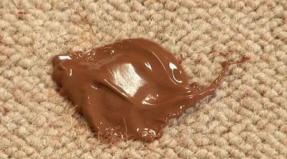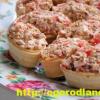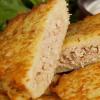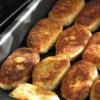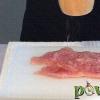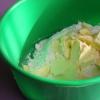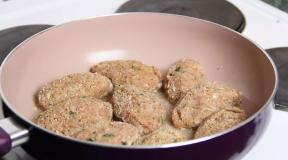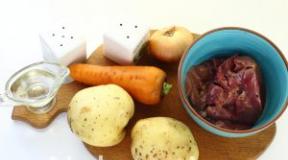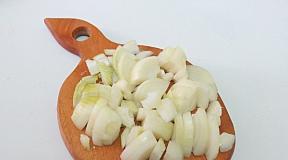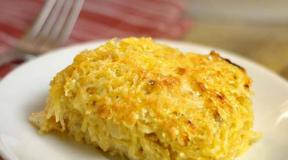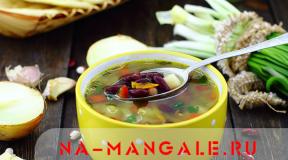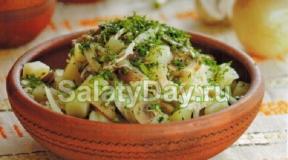What to do with mushrooms after picking - the most successful ways to process mushrooms. What to do with mushrooms after harvest: processing rules and simple recipes
Honey mushrooms are a tasty source of complete proteins, zinc, iron, phosphorus and vitamin C. The use of these mushrooms helps the body to overcome viral diseases and fill with vitality. But many housewives avoid this forest product, citing the complexity of cleaning and preparing honey mushrooms. In fact, there is nothing difficult here.
How to clean mushrooms
Honey mushrooms are a perishable product, so you need to start cleaning it immediately after returning from the forest, well, or from the store. The mushrooms are very fragile and small, but the cleaning process does not take much effort:
- Go through the harvest. All rotten, rotten and insect-damaged specimens without a twinge of conscience, send to the trash bin.
- Remove organic "debris" - twigs, leaves, earth.
- Next, you need to determine what processing the mushrooms will be subjected to. If you want to dry them, cut off the bottom segment of the leg and remove the film under the cap. If the mushrooms are required fresh, they should additionally be soaked in water (maximum 1 hour), and then peel the film (skirt).
How to cook boiled mushrooms
After cleaning, you can proceed to heat treatment of mushrooms:
- Take an enamel pot and boil some salted water in it.
- Place the mushrooms in boiling water for 10 minutes, making sure to skim off the foam.
- Drain the mushroom broth and fill the mushrooms with clean water.
- After boiling, boil the mushrooms for 30-40 minutes.
- When mushrooms are fully cooked, they will settle to the bottom of the dish.
- Discard the mushrooms in a colander and rinse them with water. This will flush out excess mucus.
How to cook fried mushrooms
Fried mushrooms with onions are probably the most delicious way to cook them:
- Pre-boil honey mushrooms.
- While they are cooking, sauté the sliced onions in the butter.
- Add honey mushrooms to the onions, season with salt, and cook for about 20 minutes.
- When serving, sprinkle the fried mushrooms with chopped green onions or basil.
How to cook salted mushrooms
Salted honey mushrooms can be used for making salads and snacks.
- Boil the mushrooms and separate the legs from the caps.
- If the mushrooms are large, cut them in half.
- Next, add chopped garlic, half rings of onion and herbs (dill or parsley) to the mushrooms.
- You can add bay leaves, peppers and other spices if desired.
- Now add salt: for every kilogram of mushrooms - 2 tbsp. l. salt.
- Mix all the ingredients, put in an enamel container and put under pressure for 5 days.
- After this time, put honey mushrooms in a sterilized jar and refrigerate.
- After 20 days, the mushrooms will be ready.


How to cook pickled mushrooms
Homemade mushrooms in the marinade are much tastier than their store counterparts.
- Boil the mushrooms.
- Do not pour out the second mushroom broth and strain.
- Prepare the marinade: 500 mg of water; 1 tbsp. l. sugar and salt; a set of spices (bay leaves, cloves, cardamom, allspice).
- Send all the components for the marinade to the mushroom broth, after boiling, add 1 tbsp. l. vinegar.
- Pour the prepared mushrooms with boiling broth.
- In 2-3 hours the mushrooms will be ready.


Cooking honey mushrooms is not a laborious culinary process. But dishes with their "participation" will always decorate a festive table or dinner with the family.
However, not every housewife knows that not only fresh ones are subject to freezing, but also those that have undergone some kind of processing. We will tell about all the secrets of correct raw, as well as those that have undergone various processing at home in this review.
Mushroom preparation
If you collect it yourself, then it is advisable to clean them of an earthen coma, various litter and small insects immediately, during the collection process. Houses must be sorted out and thoroughly cleaned of leaves and adhering dirt. Then sort the mushrooms by size. Freeze small pieces whole, and cut large pieces into several pieces.
Do I need to wash
Honey mushrooms should not be washed only if you plan to preserve them by raw freezing. Easily absorb moisture that creates ice, taking up a lot of freezer space. Excess liquid makes the workpiece heavier, and the mushroom taste becomes watery.
If the mushrooms are significantly dirty, you can wipe them with a damp cloth towel, and then dry them. At worst, you can rinse the mushrooms under running water and dry thoroughly on a linen towel. However, try not to wet the mushrooms too much.
Did you know? Mushrooms are capable of "piercing" marble. In the growth stage, the internal pressure of these amazing creatures reaches the pressure of seven atmospheres. Therefore, oddly enough, but the delicate mycelium really makes its way through hard surfaces such as asphalt, concrete, marble and even iron.
Freezing methods
Peeled mushrooms can be frozen both raw and boiled, stewed or fried. In addition, the mushrooms can be pre-blanched. The choice of freezing method depends on the recipes for the dishes that you plan to cook later. Choose the option that suits you specifically! 
Raw
All actions must be reproduced in the order shown below:
- Prepare a flat plastic stand or cutting board.
- Spread the peeled mushrooms evenly over the surface of the pallet. It is necessary to stack in one layer, as the fruits can stick together and deform.
- Set the freezer to deep freeze.
- Then the pallet with the fruits must be kept in the freezer for a short time until the mushrooms freeze.
- Pour the frozen mushrooms into plastic containers or plastic bags and send them to the freezer for long-term storage at a temperature of -18 ºC.
Pre-blanching
Some housewives prefer to blanch mushrooms before freezing, that is, pour boiling water over them. To do this, the mushrooms are washed under running water. Next, the fruits are transferred into a colander and poured over them with boiling water. When the moisture drains and the mushrooms have cooled, they are transferred to a towel. Dried mushrooms are distributed in plastic bags and transferred to the freezer. This blanching method is the simplest and most common.  There is another option for blanching, which allows you to most effectively preserve nutrients:
There is another option for blanching, which allows you to most effectively preserve nutrients:
- Prepare two large containers, a slotted spoon, a colander, and clean cloth towels.
- Prepare brine in one container (20 g of salt per 1 liter of water), pour cold water into the other (preferably with ice).
- Place the pure honey mushrooms in a boiling brine. After 2-3 minutes, use a slotted spoon to remove the mushrooms from the hot brine and immediately transfer them to a container with cold water. Such cooling instantly stops the cooking process.
- After 2-3 minutes, discard the fruits in a colander, then dry on a towel.
- Distribute the product in plastic bags.
- Send the blanks to the freezer for storage over the winter.
Chefs advise adding a pinch of citric acid to the water in which the mushrooms will be processed. This simple technique helps protect the mushrooms from darkening and bitterness.
Boiled
Many housewives prefer to freeze boiled mushrooms. Next, you will get acquainted with the main nuances of this method, and also find out how long it takes to cook mushrooms before freezing.
Step by step guide:
- Pour cold water over the fruits and cook over high heat.
- When the liquid boils and a foam forms on the surface, drain all the water.
- Rinse the mushrooms again, cover with fresh water, then set to cook. Or, boil the water, and only then lower the honey mushrooms there.
- Boil the mushrooms for another 40-50 minutes. Do not forget to lightly salt the water (10 g of table salt is required for 1 liter of liquid).
- Place the mushrooms in a colander to drain the liquid. If you wish, you can chill the fruit in cold water.
- Transfer the honey mushrooms to a dry towel.
- When the mushrooms are well dry, proceed to standard freezing (distribute the fruits in bags and transfer to the freezer for storage).

Stewed
So that honey mushrooms do not lose their piquant taste and aroma, such a preparation method as stewing was invented. Even vegetable oil is not required for such processing. Step by step guide:
- Transfer the prepared fruits to a preheated frying pan without fat.
- Season the fruit with table salt, then cover tightly. In this state, the mushrooms are more likely to start up their water.
- Without removing the lid, simmer the mushrooms in your own juice over low heat.
- Mushrooms should be stewed for at least 25-30 minutes. Therefore, if the liquid evaporates before the indicated time, add a little boiled water.
You can also stew mushrooms in the oven. To do this, simply spread the mushrooms on a baking sheet and cook them in your own juice.
Important! Don't miss the moment of complete evaporation of the liquid! It is categorically unacceptable for honey mushrooms to burn - they will acquire a bitter unpleasant aftertaste.
Fried
You can also freeze fried mushrooms:
- Transfer the clean mushrooms to a preheated pan with a small amount of sunflower oil.
- Fry the mushrooms for 20 minutes, stirring occasionally. You need to fry until all excess liquid has evaporated from the fruit.
- Set the skillet aside until the mushrooms have cooled completely.
- Distribute the workpiece into bags, wrap them tightly. Transfer the bags to the freezer for storage.

Shelf life
The shelf life of mushrooms frozen by any of the above methods is no more than one year, provided that the temperature in the freezer is 18 ºC with a minus sign. Do not forget to affix the freeze date stickers to the bags.
Important! Never forget to batch-pack the mushroom blank before storing. Thawed mushrooms should be used immediately, since the product becomes unfit for food during the second freezing.
Defrosting rules
Knowing how to properly defrost mushrooms will preserve the quality of the fruit and the texture of the dish.
It is undesirable to put honey mushrooms in the oven or microwave. Defrosting should proceed slowly at room temperature.  When you decide to defrost the raw mushrooms, transfer them to the refrigerator first. In this case, honey mushrooms will be just like fresh. After complete defrosting, the mushrooms should be dried.
When you decide to defrost the raw mushrooms, transfer them to the refrigerator first. In this case, honey mushrooms will be just like fresh. After complete defrosting, the mushrooms should be dried.
If mushrooms were stored boiled, stewed or fried, they must also be defrosted first and only then used in cooking.
Did you know? It is curious that mushrooms, along with, are considered the most ancient inhabitants of our planet. Mushrooms are older than dinosaurs, they existed 400 million years ago (long before the appearance of dinosaurs). Even the giant ones that survived to our times were significantly crushed, while the mushrooms managed to adapt (many species exist to this day).
How to cook frozen mushrooms
Summing up, consider how best to cook frozen mushrooms. So, in soups, as well as fried or stewed dishes, you can put the preparation immediately, previously without defrosting it.
Honey mushrooms are a tasty source of complete proteins, zinc, iron, phosphorus and vitamin C. The use of these mushrooms helps the body to overcome viral diseases and fill with vitality. But many housewives avoid this forest product, citing the complexity of cleaning and preparing honey mushrooms. In fact, there is nothing difficult here.
How to clean mushrooms
Honey mushrooms are a perishable product, so you need to start cleaning it immediately after returning from the forest, well, or from the store. The mushrooms are very fragile and small, but the cleaning process does not take much effort:
- Go through the harvest. All rotten, rotten and insect-damaged specimens without a twinge of conscience, send to the trash bin.
- Remove organic "debris" - twigs, leaves, earth.
- Next, you need to determine what processing the mushrooms will be subjected to. If you want to dry them, cut off the bottom segment of the leg and remove the film under the cap. If the mushrooms are required fresh, they should additionally be soaked in water (maximum 1 hour), and then peel the film (skirt).
How to cook boiled mushrooms
After cleaning, you can proceed to heat treatment of mushrooms:
- Take an enamel pot and boil some salted water in it.
- Place the mushrooms in boiling water for 10 minutes, making sure to skim off the foam.
- Drain the mushroom broth and fill the mushrooms with clean water.
- After boiling, boil the mushrooms for 30-40 minutes.
- When mushrooms are fully cooked, they will settle to the bottom of the dish.
- Discard the mushrooms in a colander and rinse them with water. This will flush out excess mucus.
How to cook fried mushrooms
Fried mushrooms with onions are probably the most delicious way to cook them:
- Pre-boil honey mushrooms.
- While they are cooking, sauté the sliced onions in the butter.
- Add honey mushrooms to the onions, season with salt, and cook for about 20 minutes.
- When serving, sprinkle the fried mushrooms with chopped green onions or basil.

How to cook salted mushrooms
Salted honey mushrooms can be used for making salads and snacks.
- Boil the mushrooms and separate the legs from the caps.
- If the mushrooms are large, cut them in half.
- Next, add chopped garlic, half rings of onion and herbs (dill or parsley) to the mushrooms.
- You can add bay leaves, peppers and other spices if desired.
- Now add salt: for every kilogram of mushrooms - 2 tbsp. l. salt.
- Mix all the ingredients, put in an enamel container and put under pressure for 5 days.
- After this time, put honey mushrooms in a sterilized jar and refrigerate.
- After 20 days, the mushrooms will be ready.

How to cook pickled mushrooms
Homemade mushrooms in the marinade are much tastier than their store counterparts.
- Boil the mushrooms.
- Do not pour out the second mushroom broth and strain.
- Prepare the marinade: 500 mg of water; 1 tbsp. l. sugar and salt; a set of spices (bay leaves, cloves, cardamom, allspice).
- Send all the components for the marinade to the mushroom broth, after boiling, add 1 tbsp. l. vinegar.
- Pour the prepared mushrooms with boiling broth.
- In 2-3 hours the mushrooms will be ready.

Cooking honey mushrooms is not a laborious culinary process. But dishes with their "participation" will always decorate a festive table or dinner with the family.
They are, perhaps, one of the most common. While most of the "noble" species grow mostly singly, honey mushrooms are usually found in whole "families", so it is much easier to collect them. Given the fairly wide distribution of these mushrooms in regions with different climates, as well as the rich content of a number of vitamins (B vitamins, ascorbic acid, vitamin E, PP and others) in them, they are a fairly popular ingredient in many dishes.
Despite the rather wide popularity, many still have doubts about whether it is necessary to clean mushrooms. Like any other type of mushroom, honey mushrooms must be properly cleaned before use for cooking.
We will consider this process in more detail below.
How to properly clean honey mushrooms
Before cleaning honey mushrooms, it is advisable to sort them. From the total amount of collected mushrooms, it is advisable to remove old mushrooms, as well as those showing signs of damage by worms, insects or rot. If there are signs of damage only on the stem of the fungus, it can be removed, leaving the cap. In case of significant damage to the fungus, it is better to discard it whole.
Many mushroom pickers use a knife to remove the wavy "collar" from the stem of the mushroom. In fact, there is no need for this, even with this fragment the taste of the final dish does not change. Therefore, in this case, the need for this manipulation is dictated rather by aesthetic motives.
After that, you need to choose a method of how to clean mushrooms, based on whether these mushrooms are intended for drying or not.
In the event that the harvested crop is planned to be dried, it is impossible to soak the mushrooms before cleaning. It is also undesirable to wash them under running water. This is due to the fact that mushrooms absorb moisture very strongly, and if they are washed with water, it will no longer be possible to dry them qualitatively.
If the mushrooms are planned to be dried, honey agarics can only be cleaned using a dry method. In this case, the dirt, sand, small needles, fragments of leaves and other debris on the mushrooms are removed with a piece of dry cloth or with a small brush with a hard bristle. Many people use an old toothbrush for this purpose.
In the event that the mushrooms are planned to be consumed fresh, or preserved in a boiled form, then before cleaning the mushrooms, they can be soaked in a container with warm water. It is not worth keeping mushrooms in water for too long (more than an hour), they can become highly saturated with moisture and lose their taste.
After soaking, you can remove the existing dirt in any convenient way (for example, using a brush). In this case, it will be much easier to clean mushrooms than with a dry method.
The most precious thing we are given in life is health. Therefore, it should be monitored regularly. Particular attention should be paid to the water in which we prepare food every day. Chemical analysis of water is very important. Details on the website.
Forest mushrooms are good fried and pickled. They make a very tasty soup, especially if the mushrooms are dried. How to properly clean mushrooms in order to start cooking them further - this will be discussed in the article.
General rules for cleaning honey agarics
- Sort out the mushrooms and remove the broken and wormy ones.
- Use a sharp knife to cut off the lowest parts of the legs, where there may be remnants of earth and sand.
- Honey mushrooms, unlike some other mushrooms, do not have a mucous membrane on the cap. So there is no need to shoot it, which greatly simplifies the matter.
If there are a lot of mushrooms in the forest, then you can take only their caps, so as not to clean the legs in the future.
How to clean mushrooms for further canning
Some species of honey agaric have a so-called skirt on a leg - it gets soaked in brine and does not look very aesthetically pleasing. Since pickled mushrooms are served as a snack, and it should be beautiful, it is better to remove this skirt with a thin knife. And of course, before pickling, wash the mushrooms well in running water.

How to clean mushrooms for further frying
For frying honey mushrooms, process as indicated in paragraph 1 of this article. You do not need to remove the skirt, because when frying it will dry out and will not be visible.

How to clean honey mushrooms for further cooking in soup
Cleaning honey agarics for soup depends on what kind of dish the hostess will cook. For puree soup, you should not remove the skirt, because the mushrooms will be killed by a blender and turn into a homogeneous mass. For a clear soup, so that it is beautiful, the skirt can be removed.

How to clean mushrooms for further drying
Dried mushrooms have a rich taste and aroma and are good in any dishes. Process the mushrooms before drying as follows:
- Go through the trash.
- Cut off the bottom of the legs.
- Remove the skirts.
- Remove dust and sand from the caps with a soft brush.
- Put clean dry mushrooms on threads (use a long needle) and hang them in a warm, ventilated place to dry.
- Before cooking, soak dry mushrooms in cold water - they will leave the remaining sand.

To clean mushrooms, they must first be collected in the forest. Where they grow and how they look, see the video clip.
Small mushrooms with round caps appear in friendly groups on green meadows or stumps. Fragrant honey mushrooms, generous for the harvest, have a delicate taste and are suitable for a variety of mushroom dishes. They are successfully salted, pickled, boiled and roasted. A few small fragrant mushrooms will spice up potato soup or pasta, making the simplest dish original, hearty and healthy.
Types of honey agarics
There are several species that differ in time and place of growth, as well as taste and appearance.
Autumn mushrooms (real) (Armillaria mellea)

Groups of autumn or real honey agarics can be found in late summer and early autumn on stumps and living trees, most often on birch, less often on aspens, maples and other deciduous species.
This, the most delicious and fragrant species, is rather large and is characterized by a rounded cap with a diameter of 5–12 cm, initially convex, and then wide, which becomes smooth, outstretched, and brown with age. The young skin is light brown and as if sprinkled with dark scaly crumbs.
The leg is slender, up to 10 cm high, with a typical white ring, light cream at the top, darker at the base. The plates are white, the flesh has a pleasant sourish, slightly tart taste.

Early small mushrooms with an orange-brown cap and a noticeable watery patch in the center appear on trees from late May until late autumn. A hat with a diameter of up to 5 cm opens over time and sheds the bottom blanket. The leg is thin, hollow, up to 6 cm high with a dark ring.
Mushrooms grow together in a colony, sit tightly on damaged deciduous wood. The plates are creamy brown, the flesh is brownish-red, fragile, with a delicate smell of fresh wood. The fruit body is slightly bitter and can only be used boiled.

Flocks of sunny meadow mushrooms appear among meadow grass, on the edges and along forest clearings, starting in May, and disappear by the end of summer. The hat is small, about 3 cm in diameter, with a slight elevation in the center, and a beige-orange skin. The leg is thin, up to 7 cm high. The plates are creamy, rare, the flesh is yellowish, with a pleasant sweetish taste.
Colonies often form in circles, leaving an empty patch in the center. In the old days, this phenomenon was called witch's circles. In fact, the explanation is simple - ripe spores throw out long thin cobweb-like threads in all directions, at the ends of which fruiting bodies rise along the entire circumference. There are few nutrients left in the center of the mushroom clearing, so the grass does not grow there, it dries up, forming small round wastelands.

Even during winter thaws, under the snow, on old poplars or willows, you can find beautiful even hats of winter honey agarics. They are medium in size, up to 8 cm in diameter, the skin color is buffy-brown, in damp it is slippery, smooth, in dry weather, glossy. The leg is hollow, velvety, about 6 cm high, darkens noticeably towards the base, changing color from light brown in the upper part to dark brown or burgundy at the bottom. Thin cream-colored pulp, neutral taste, with a barely perceptible mushroom aroma, creamy plates, frequent.
Winter mushrooms are good boiled, pickled and in pickles. It is surprisingly pleasant to collect these gifts of nature from under the snow in a cold season. The species is cultivated on an industrial scale and is known under the names "monoki" and "enokitake".
Distribution locations and collection times
In mid-May, a slender mushroom dance begins summer mushrooms, they are sometimes called spring. The species occurs up to the beginning of September, quite often among humid forests, appearing in large colonies on deciduous wood. It is advisable to collect them by cutting off some of the caps, since the hollow thin stem is tough, fibrous, and does not represent nutritional value.
At the end of May, singly, or even in groups, appear meadow mushrooms that burst into warm yellow-brown color among the grass in forest clearings, pastures, along paths and ravines. The crops can be harvested before the beginning of autumn.
The end of August and the time of the first drizzling rain is the time to collect real or autumn honey agarics... It is easier to find them on the wood of birches and aspens - on stumps and old trees. These perky mushrooms are harvested until late autumn. Already frost can silver the grass, but they are still visible on the stumps.
In mid-September, the first winter mushrooms, appearing as accrete groups on the fallen trees and stumps of poplars, willows and maples. Their appearance is a sign of a weakened or old tree. You can find them in forests, parks, old orchards, artificial plantations. Fruit bodies are harvested not only throughout the autumn until the onset of winter and severe frosts, but also during the winter thaws, until the arrival of the real May heat.
False mushrooms
Honey mushrooms are good for everyone - fruitful, tasty, fragrant mushrooms that can be harvested for a whole year. But there is one significant drawback - the presence of similar species, which, at best, are classified as conditionally edible, and at worst, poisonous. The danger is aggravated by the fact that some twins are not only very similar, but also grow next to edible mushrooms, literally on the same stump.

The most dangerous of the doubles, a very poisonous species. A thinned hat, up to 6 cm in diameter, mustard yellow, reminiscent of the color of sulfur, with a darkening center - brown or burgundy. In young mushrooms, the cap is convex, in old ones it is widely spread. The plates are fused with the stem, yellow-brown, later brown. The leg is hollow, curved, greenish, below the dark shade. The pulp is poisonous-bitter, with a disgusting odor, yellowish in color. It is this bitter wormwood taste that prevents serious poisoning.
You can meet groups of these mushrooms from the end of June to September, in places where edible species grow. In addition to the poisonous color, bitterness and unpleasant odor, false mushrooms can be distinguished by the color of the spores: in the false froth of sulfur-yellow, the spores are greenish, in summer mushrooms they are brown, and in autumn mushrooms they are white. However, twins grown on coniferous wood may not have spores at all.
A noticeable difference between real honey agarics is the presence of a ring or "skirt" - the remains of a discarded veil, which is not present in false species.

Appears in small colonies on decaying wood in late summer and early autumn. A cap with a large tubercle in the center, light yellow or cream, up to 6 cm in diameter, covered with whitish flakes along the edge.
The pulp is fragile, thin, whitish-yellow, at first the plates are off-white, grayish, with age they turn purple. Legs are thin, brittle, yellow at the top, brown at the bottom, grow together at the base. The species is classified as conditionally edible.

The bright mushroom forms large colonies, visible from afar for its red tones. The caps are shiny, reddish-red in color, the light edges are strewn with grayish flakes. The pulp is mustard yellow, bitter. Appears in late autumn on hardwood stumps, more often oak and beech.
Fruiting bodies are suitable for human consumption, but because of the bitter taste, it requires boiling twice with a change of water.

Another name is psatirella watery, and there is no consensus about its use - sometimes the mushroom is considered inedible, and in other cases conditionally edible. The hat is 3-5 cm in diameter, slightly convex or outstretched, with cracked thinned edges. The skin is glossy, brown, with aging it brightens from a cent and becomes creamy, on the edges there are flocculent residues of the bedspread. Spores are brown-violet.
The pulp is brown in color and has a characteristic watery consistency, neutral taste, sometimes with a slight bitterness, odorless. Leg up to 8 cm tall, hollow, often curved, in the upper part covered with a weak mealy bloom.
It appears in the autumn months in damp places near trees or on stumps, the remains of both deciduous and coniferous wood. Sometimes it develops in the form of large colonies.

This mushroom is a close relative of the previous species and is also known under the name of Candoll's psatirella. The cap is slightly convex, then outstretched, up to 8 cm in diameter, with wrinkles radially running from the center to the edges, when it dries, it becomes white or creamy. The skin is brownish in color, in young mushrooms it is covered with scales, which disappear with age. The pulp is thin, brittle, tasteless with a light mushroom aroma. Spores are brownish purple.
Psatirella Candolla grows from late spring to early autumn, in groups on the wood of deciduous trees and near stumps. Food use is controversial - the mushroom is considered conditionally edible or inedible. Connoisseurs find it quite tasty by steeping, boiling, and then using for marinades and frying.
All of the listed conditionally edible species are boiled for a long time before use, changing the water several times, and only then are they used for food.
Beneficial features
Honey mushrooms are recognized as tasty, aromatic mushrooms and, being fruitful and affordable, are eagerly collected by mushroom pickers. The structure of fruit bodies includes easily digestible proteins, including valuable amino acids. At the same time, they have a low calorie content - only 18–20 kcal per 100 g of finished product and can be successfully used as a source of valuable nutrients for weight loss.
Honey mushrooms are rich in trace elements useful for the hematopoietic system - zinc and copper, only 100 g of these mushrooms will satisfy the daily need for these elements. They contain B vitamins, especially a lot of thiamine, and ascorbic acid, which have a positive effect on the immune system and the nervous system.
In the composition of winter mushrooms, the anti-cancer substance flammulin was found, which has a depressing effect on the development of sarcoma.
In the tissues of meadow mushroom, researchers have found antibacterial compounds that slow down the development of Staphylococcus aureus and other virulent microorganisms.
Contraindications to use
Honey mushrooms of various types are grown on an industrial scale on wood waste or straw, being considered a useful food product, and in some countries - a delicacy.
Yet eating is associated with risks for people with inflammation of the stomach and pancreas.
Contraindications to use - diseases of the liver and gallbladder, including its resection.
Improperly cooked, undercooked mushroom dishes without sufficient heat treatment can cause indigestion and allergic reactions.
Mushroom products should not be included in the diet of children under three years of age, pregnant and lactating women.
Recipes for dishes and preparations
Before processing, the mushrooms are thoroughly washed and cleaned. In most cases, the legs have no nutritional value (except for autumn mushrooms) and therefore are removed. To successfully wash fragile hats, they are immersed in a colander and repeatedly dipped in a basin of clean water, which is changed as it gets dirty.
Pickles from autumn mushrooms
For 1 kg of autumn mushrooms, take 50 g of salt, 20 g of dill - herbs and seeds, 20 g of onions, allspice and bay leaf to taste.
Mushrooms are poured with boiling salted water and boiled for 20 minutes, and after cooking they are thrown into a colander. A thin layer of a mixture of dill, pepper and salt is poured into the previously prepared container. After cooling, the workpiece is placed in a container in rows 5–6 cm thick, sprinkling each layer with a mixture of salt and spices, as well as finely chopped onions.
From above, the pickles are covered with a piece of cloth, pressed down with a circle and a load, and taken out to a cool place, making sure that the brine completely covers them, which should happen in a few days. Food is ready in two weeks, after which it is stored in the refrigerator.
Frozen honey mushrooms
Freezing is one of the best ways to preserve the nutritional value of mushrooms. This is a simple and not laborious method that allows you to postpone the cooking process for a winter free from work. Before freezing, the mushrooms are cleaned, washed and dried. Then the workpiece is placed in portioned plastic bags or plastic containers, and placed in the freezer.
This frozen product can be stored deep-frozen at 18 ° C until next harvest. Taking a portion from the freezer, they immediately start cooking, without waiting for complete defrosting.
Canned mushrooms
Freshly harvested caps are suitable for preservation. They are washed and poured with cold water at the rate of 200 g of water per 1 kg of mushrooms. Then boil over low heat until the juice is released, after which they continue cooking for another half hour, removing the foam and stirring often. Salt the workpiece to taste, add a little citric acid - 1 g per 1 kg of mushrooms.
Bay leaves, black and allspice pepper are placed on the bottom of the jars. Boiling hats are laid out in jars and poured with mushroom broth. Preservation is sterilized for at least 40 minutes.
Video about mushrooms
Various mushrooms, compactly growing near stumps and among lush meadow grass, are useful, nutritious and tasty. They are suitable for preparations, first and second courses, contain valuable antibacterial substances, vitamins and minerals. A knowledgeable mushroom picker will not ignore these small fragrant mushrooms, and there is always a place for them in the basket, near the noble boletus and bright mushrooms.
A trip to the forest for mushrooms will in any case bring you pleasant emotions, since these mushrooms grow in large families and, having found a suitable tree, you can quickly fill the basket. The collection is carried out almost all year round, since there are many types of these mushrooms, and they can be harvested even in winter. But for this you need not only to know what edible species look like, but also by what rules they are collected.
Features and methods of collecting winter, spring and autumn honey agarics with photos and videos can be found in this article. It will help experienced mushroom pickers improve their knowledge, and beginners - to master the necessary technique.
With the onset of the first autumn month, it is time to collect honey agarics. In high humidity conditions, they grow very quickly. They can be found both in deciduous and mixed forests on stumps and old trees (Figure 1). Although these are small, collecting them is a real pleasure, because they grow up with whole families, and you can immediately pick up a whole basket of fragrant forest gifts.
 Figure 1. Places and rules for collecting honey agarics
Figure 1. Places and rules for collecting honey agarics Sometimes they hide under a layer of fallen leaves, and then it becomes more difficult to find them, but how great is the joy of a mushroom picker who discovered a family growing on a stump. Fans of quiet hunting are well aware of the features, conditions and rules of collection, and it will be useful for beginners to familiarize themselves with the materials of this article.
Peculiarities
You should be aware that various species can be harvested almost all year round, except for the period of severe frosts. So, autumn ones are harvested from August to November, meadow ones - from May to June and from September to October, summer ones bear fruit from August to October, and winter ones - throughout the fall until frost.
Note: You need to look for them in sufficiently mature deciduous forests, on stumps and trunks of fallen trees, and sometimes on living wood. The exception is meadows, which grow exclusively in open areas among the grass. Look for them on forest edges, pastures, fields, meadows.
During collection, be careful and remember that along with edibles, you can also meet false ones, among which there are poisonous ones. To prevent such a copy from accidentally ending up in your basket, learn to distinguish between real and false copies (Figure 2).
Here's what to look out for
- True mushrooms grow only on wood, while false mushrooms can grow on the ground.
- The hats of the false species are painted in bright colors - bright red, greenish-gray, and the plates on their back are dark in color.
- The main sign of edibility is the leathery ring on the leg under the cap. False ones have scraps of such a ring, while they are poorly visible. In addition, the cap and leg of a real mushroom are covered with scales that are completely absent in false ones.
 Figure 2. The main differences between real and false species
Figure 2. The main differences between real and false species In addition, the real varieties have a pleasant mushroom aroma, while the false ones give off an unpleasant earthy smell.
Conditions
If you want to reap the harvest, go to the forest, which is over 30 years old. In such a forest, you can find enough places where honey mushrooms like to grow - rotten stumps, dead trunks, dead wood, protruding tree roots.
When to collect winter and other species? The best time for this is called early morning, because it is then that they are still fresh and dense after the night coolness, which means they are more resistant to transportation and storage.
The ways
When choosing a collection method, preference should be given to those that protect the mycelium from mechanical damage. Therefore, it is unacceptable to pull out mushrooms, because such actions lead not only to damage to the mycelium, but also to its death, as a result of which growth in this area stops.
It is recommended to carefully cut off the leg with a knife or twist the mushroom out of the mycelium. However, with the first method, there is a risk of infection entering the mycelium through a cut wound on the leg, so it is better to use the second method. Unscrewing the mushroom, it must be rotated around its axis until it easily separates. The hole remaining after such actions must be trampled or slightly dug in.
rules
All lovers of "quiet hunting", be it an experienced mushroom picker or a beginner, must observe the following rules (Figure 3):
- Only familiar species can be collected. At the slightest doubt about the edibility, it should be discarded.
- It is recommended to select young healthy mushrooms, because they have the ability to accumulate dangerous toxic substances in themselves, and therefore you do not need overgrown, wormy, rotten specimens. It is better to hang it on a branch with the cap down, so that the wind can spread and disperse its spores for the future harvest. However, you should not pick too young, not yet ripe mushrooms. Leave them to other mushroom pickers.
- Try not to damage the mycelium. Therefore, it is better to twist tubular species, and lamellar and marsupials - to break or cut.
- Having found an edible mushroom, do not rush to leave this place. Most species grow in whole families, so in one place, with a careful search, you can find many fungi.
- Remember that mushrooms do not grow in tall grass and windbreak.
- When going into the forest, take a basket with you, not a bucket, because in a confined space without ventilation, mushrooms quickly suffocate.
- Before sending your find to the trash can, clear it of dirt and debris. Lay them caps down or sideways.
- Do not try to carry all the mushrooms out of the forest. It's impossible. Raw mushrooms spoil quickly and must be processed quickly.
 Figure 3. Methods and rules of collection
Figure 3. Methods and rules of collection Don't shoot unfamiliar mushrooms. After all, there may be a mushroom picker who not only recognizes this mushroom, but also picks it up.
Gathering honey agarics: video
To learn more about the collection process, we recommend that you watch the video, which shows where to look for mushrooms, how to distinguish them and how to collect them correctly.
When to collect winter mushrooms
Most mushrooms are harvested during the summer and autumn months. The exception is winter varieties, the harvest of which can be harvested even with the onset of slight cold weather in December, and in conditions of early and warm spring - in January and March. They appear in the forest in October and can continue to bear fruit until March (Figure 4). It all depends on climatic and weather conditions, because at temperatures below zero, growth stops.
 Figure 4. Collection of winter species
Figure 4. Collection of winter species It is very difficult to confuse a winter variety with any other species, since most mushrooms do not tolerate cold weather, and with their onset they die off in their aboveground part, which means they are simply absent.
When to collect spring mushrooms
Spring mushrooms are early species. They can be found in both mixed and coniferous forests on old stumps and protruding tree roots, as well as on damp mossy litter from mid-May to late October (Figure 5).
 Figure 5. Features of the collection of spring species
Figure 5. Features of the collection of spring species The largest harvest can be harvested in June-July, when these mushrooms are especially fertile, and since they grow in a low-mushroom season, they are of great interest to mushroom pickers.
Collecting autumn mushrooms: video
The most popular are autumn varieties. In the video below, you will learn how to harvest them correctly and what places in the forest should be explored in order to find a rich harvest of mushrooms.




